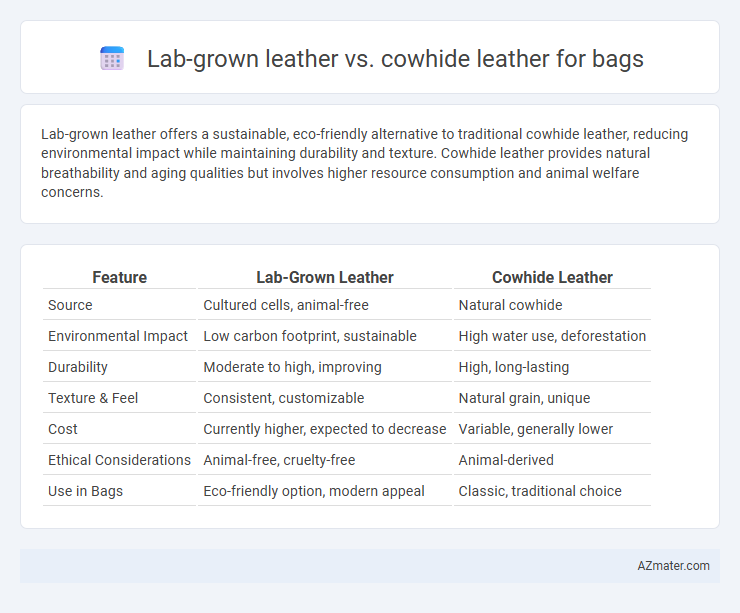Lab-grown leather offers a sustainable, eco-friendly alternative to traditional cowhide leather, reducing environmental impact while maintaining durability and texture. Cowhide leather provides natural breathability and aging qualities but involves higher resource consumption and animal welfare concerns.
Table of Comparison
| Feature | Lab-Grown Leather | Cowhide Leather |
|---|---|---|
| Source | Cultured cells, animal-free | Natural cowhide |
| Environmental Impact | Low carbon footprint, sustainable | High water use, deforestation |
| Durability | Moderate to high, improving | High, long-lasting |
| Texture & Feel | Consistent, customizable | Natural grain, unique |
| Cost | Currently higher, expected to decrease | Variable, generally lower |
| Ethical Considerations | Animal-free, cruelty-free | Animal-derived |
| Use in Bags | Eco-friendly option, modern appeal | Classic, traditional choice |
Introduction to Lab-Grown and Cowhide Leather
Lab-grown leather is a sustainable alternative produced by cultivating animal cells in a lab environment, mimicking the texture and durability of traditional leather without the environmental impact of livestock farming. Cowhide leather, derived from the hides of cattle, is known for its natural strength, longevity, and classic appearance, widely used in high-quality bags. Innovations in lab-grown leather aim to replicate cowhide's grain patterns and resilience while reducing carbon footprint and water usage in manufacturing.
How Lab-Grown Leather Is Made
Lab-grown leather is produced through a biofabrication process that cultivates animal cells in a controlled environment, eliminating the need for animal slaughter. This method uses collagen-producing cells harvested from biopsies, which are then grown on scaffolds to form durable, flexible leather material. Compared to traditional cowhide leather, lab-grown leather offers a sustainable alternative with a significantly reduced environmental footprint and fewer chemical treatments.
Traditional Cowhide Leather Production
Traditional cowhide leather production involves the raising and slaughtering of cattle, which requires significant land, water, and feed resources, contributing to environmental degradation and greenhouse gas emissions. The tanning process uses chemicals like chromium, often resulting in toxic waste and pollution affecting both ecosystems and workers' health. In contrast, lab-grown leather offers a sustainable alternative by eliminating the need for livestock and reducing reliance on harmful chemicals, while still mimicking the durability and texture valued in conventional cowhide leather bags.
Environmental Impact: Lab-Grown vs Cowhide
Lab-grown leather significantly reduces environmental impact by minimizing greenhouse gas emissions and water usage compared to traditional cowhide leather production. Cowhide leather involves intensive livestock farming, which contributes substantially to deforestation, methane emissions, and excessive water consumption. Lab-grown leather offers a sustainable alternative by utilizing biotechnology to produce durable material without the extensive resource demands and ecological degradation associated with cattle agriculture.
Durability and Longevity Comparison
Lab-grown leather offers enhanced durability due to its engineered fibers that resist cracking and wear better than traditional cowhide leather. Cowhide leather, while naturally strong and flexible, tends to develop scratches and creases over time, impacting its longevity. In terms of lifespan, lab-grown leather maintains its structural integrity longer under daily use, making it a superior choice for bag durability.
Aesthetic and Texture Differences
Lab-grown leather offers a consistent, smooth texture with customizable grain patterns that enhance aesthetic appeal, making it ideal for sleek, modern bag designs. Cowhide leather presents a natural, unique texture marked by visible pores, scars, and creases that contribute to a rugged, authentic look prized in luxury and vintage-style bags. The tactile experience of cowhide is typically firmer and more substantial, while lab-grown leather tends to be softer and more pliable, adapting easily to intricate shapes and detailed craftsmanship.
Cost and Accessibility Considerations
Lab-grown leather typically costs more upfront due to advanced manufacturing technology but offers consistent quality and scalability, making it an appealing choice for eco-conscious brands seeking innovation. Cowhide leather remains more accessible and affordable in many markets because of established supply chains and traditional tanning processes, which sustain cost-efficiency and widespread availability. The cost-benefit balance favors cowhide for budget-conscious consumers, while lab-grown leather appeals to those prioritizing sustainability and ethical production in premium bag markets.
Ethical and Animal Welfare Concerns
Lab-grown leather offers a cruelty-free alternative to traditional cowhide leather by eliminating the need to raise and slaughter animals, significantly reducing animal suffering and ethical concerns associated with leather production. Cowhide leather involves the direct use of animal hides from cattle, raising ethical issues related to animal welfare, intensive farming practices, and the environmental impact of livestock rearing. Choosing lab-grown leather for bags supports sustainable and humane fashion practices while addressing the growing consumer demand for ethically sourced materials.
Consumer Preferences and Market Trends
Consumer preferences are increasingly shifting towards lab-grown leather for bags due to its sustainability and ethical manufacturing process, appealing to environmentally conscious buyers. Market trends indicate a rising demand for lab-grown leather, driven by advancements in biotechnology that improve texture and durability, closely mimicking traditional cowhide leather. Despite cowhide's longstanding reputation for toughness and natural aging characteristics, lab-grown leather is rapidly gaining traction in premium and eco-friendly product segments.
Future Outlook: Sustainable Bag Manufacturing
Lab-grown leather offers a revolutionary approach to sustainable bag manufacturing by drastically reducing the environmental impact associated with traditional cowhide leather, including lower greenhouse gas emissions and water usage. Innovations in biotechnology and material science continue to enhance the durability and aesthetic qualities of lab-grown leather, positioning it as a viable alternative for eco-conscious brands. As consumer demand for sustainable fashion rises, lab-grown leather is set to play a pivotal role in transforming the bag industry toward a more environmentally responsible future.

Infographic: Lab-grown leather vs Cowhide leather for Bag
 azmater.com
azmater.com